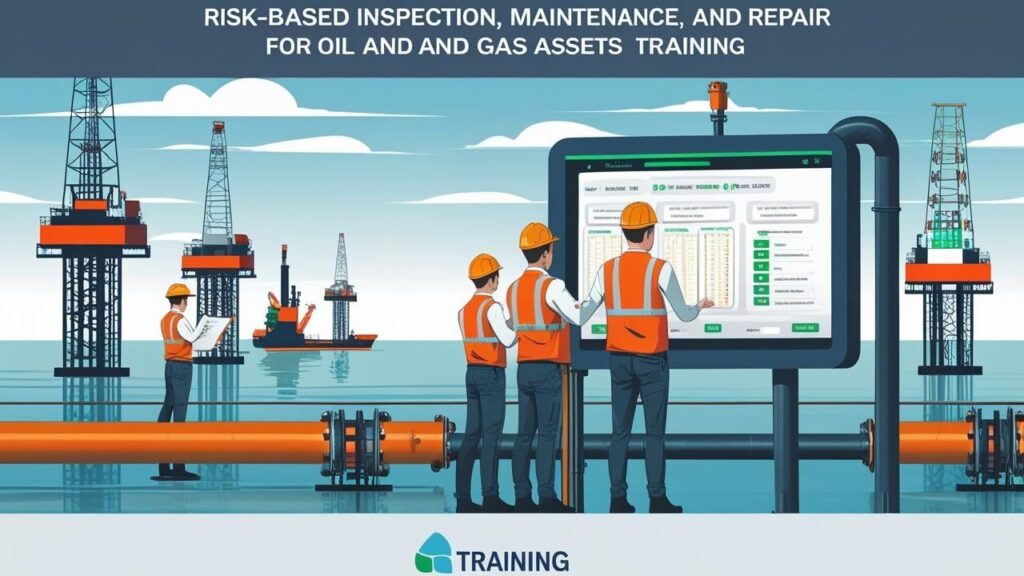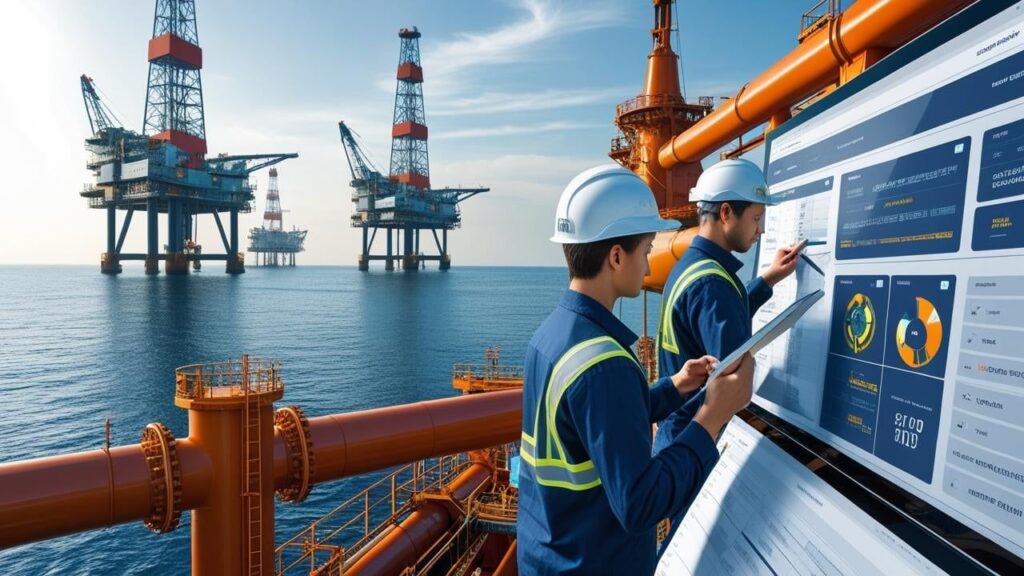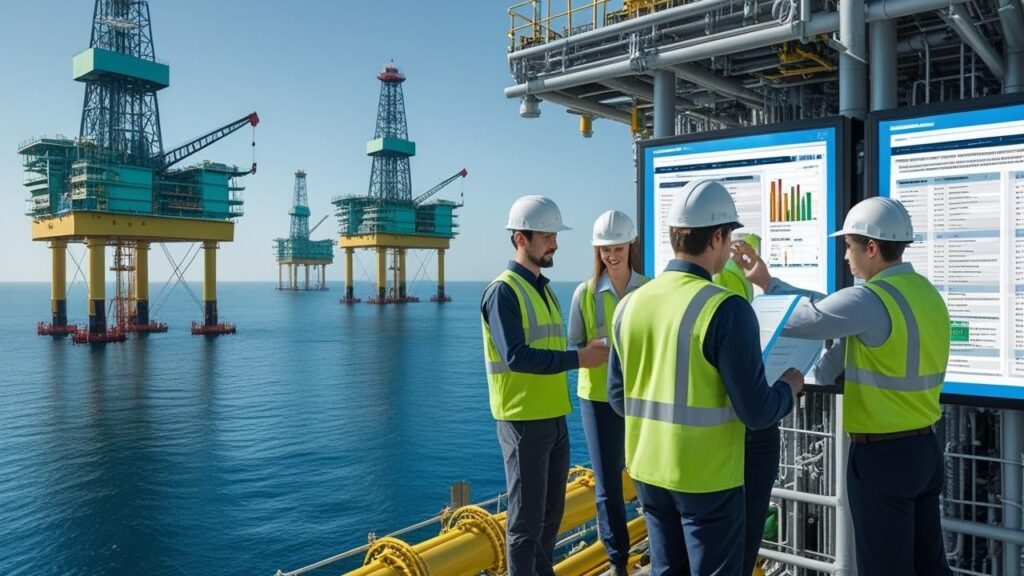Risk-Based

Inspection, Maintenance, and Repair – Oil and Gas Assets Training
1. Introduction
The oil and gas industry operates in highly complex, hazardous, and regulated environments. Asset integrity and safety are critical priorities due to the severe consequences of failures, such as environmental damage, loss of life, financial penalties, and reputational harm. In this context, Risk-Based Inspection, Maintenance, and Repair (RBIMR) has emerged as a powerful methodology to optimize asset performance, minimize downtime, and ensure safety and compliance.
This training document provides a comprehensive overview of the RBIMR methodology as applied to oil and gas assets. It includes fundamental concepts, implementation strategies, tools, and case studies to support effective application across upstream, midstream, and downstream operations.
2. Objectives of RBIMR
The main objectives of RBIMR are:
To identify and assess risks associated with asset degradation and failure.
To prioritize inspection and maintenance based on risk levels.
To optimize resource allocation and reduce unnecessary interventions.
To increase operational uptime and reliability.
To extend asset life through informed repair strategies.
To comply with regulatory standards and industry best practices.
3. Fundamentals of Risk
3.1. What is Risk?
In the context of asset integrity, risk is typically defined as:
Risk = Probability of Failure (PoF) × Consequence of Failure (CoF)
PoF refers to the likelihood of an asset or component failing due to degradation mechanisms (e.g., corrosion, fatigue, erosion).
CoF includes potential impacts such as safety hazards, environmental damage, production loss, and financial penalties.
3.2. Risk Categories
Risks are often categorized into the following domains:
Health, Safety, and Environment (HSE) Risks
Production and Operational Risks
Financial and Business Risks
Regulatory and Legal Risks
4. Risk-Based Inspection (RBI)
4.1. Overview
Risk-Based Inspection (RBI) is a structured approach that uses risk assessment to develop optimized inspection plans. Instead of applying uniform inspection intervals, RBI focuses resources on high-risk components.
4.2. RBI Methodologies
Two primary approaches are used:
Qualitative RBI: Based on expert judgment, decision trees, and descriptive risk matrices.
Quantitative RBI: Uses numeric data, modeling tools, and probabilistic techniques for more precise risk estimation.
4.3. Key Steps in RBI Process
Data Collection: Asset information, operating conditions, historical failure data.
Degradation Mechanism Identification: E.g., general corrosion, SCC, hydrogen embrittlement.
Probability of Failure Analysis: Based on degradation rate, material properties, and operating history.
Consequence of Failure Analysis: Evaluates impact scenarios (fire, explosion, spills).
Risk Evaluation: Combine PoF and CoF to determine risk ranking.
Inspection Planning: Determine inspection frequency, technique, and scope.
Execution & Feedback: Conduct inspections and feed results into future assessments.
4.4. Common RBI Standards
API 580: Risk-Based Inspection
API 581: Risk-Based Inspection Technology
DNV-RP-G101: RBI of Offshore Structures
ASME PCC-3: Inspection Planning Using RBI
5. Maintenance Strategies
5.1. Types of Maintenance
Reactive (Breakdown) Maintenance: Performed after failure.
Preventive Maintenance (PM): Based on scheduled intervals.
Predictive Maintenance (PdM): Uses real-time condition monitoring (e.g., vibration, thermography).
Risk-Based Maintenance (RBM): Prioritized based on asset risk profiles.
5.2. Integrating RBI and Maintenance
By integrating RBI with maintenance, companies can:
Reduce unplanned outages.
Avoid over-maintenance of low-risk equipment.
Increase focus on critical assets.
Improve resource efficiency.
5.3. Maintenance Planning Cycle
Asset Criticality Assessment
Failure Mode and Effects Analysis (FMEA)
Maintenance Task Identification
Resource Allocation
Execution and Monitoring
Performance Review and Optimization
6. Repair and Mitigation Strategies
6.1. Repair vs. Replacement Decision-Making
RBIMR supports the decision-making process between repair, replacement, or continued operation with monitoring. This depends on:


Risk assessment outcomes
Remaining Life Estimation (RLE)
Cost-benefit analysis
Regulatory compliance
6.2. Common Repair Techniques
Welding Repairs
Composite Wraps
Clamping and Sleeving
Internal Linings and Coatings
Hot Tapping and Line Stopping
6.3. Temporary vs. Permanent Repairs
Temporary Repairs are short-term, risk-accepted solutions with limited life.
Permanent Repairs are designed and documented according to standards like ASME PCC-2, ISO 24817, and API 570.
7. Implementation Framework for RBIMR
7.1. Organizational Readiness
Successful RBIMR implementation requires:
Leadership commitment
Multidisciplinary teams (inspection, maintenance, process, safety)
Training and competence development
IT and data infrastructure
7.2. Data Management
Effective risk assessment depends on accurate and accessible data, including:
Design specifications
Operating history
Inspection records
Maintenance logs
Process data (pressure, temperature, flow)
7.3. Software Tools
RBIMR programs typically use specialized tools for analysis and planning. Examples include:
SAP PM and IBM Maximo (CMMS)
Meridium APM / GE APM
DNV Synergi Plant
PCMS by E2G
Capstone RBI
8. Case Studies
8.1. Upstream Facility – Offshore Platform
An offshore platform implemented RBI to reduce inspection campaigns. After conducting a quantitative RBI on its pressure vessels and piping, the number of inspections was reduced by 30%, with an associated OPEX savings of over $1 million annually.
Degradation mechanisms identified: CO₂ corrosion and chloride-induced pitting.
Mitigation: Coating, cathodic protection, and online corrosion monitoring.
Outcome: No failures detected over 5-year monitoring cycle.
8.2. Midstream Pipeline Network
A gas pipeline operator used RBIMR to prioritize inline inspection (ILI) and external corrosion direct assessment (ECDA).
Findings: Older segments near road crossings had higher CoF.
Action: Focused inspections and repair work on high-risk segments.
Benefit: Reduced risk of leak incidents by 60% within 3 years.
8.3. Downstream Refinery
A refinery applied RBI across heat exchangers and columns. A critical exchanger previously inspected every two years was reassigned a five-year interval.
Justification: Low PoF, moderate CoF, redundant process capacity.
Result: Cost reduction of $250,000 per inspection cycle without increased risk.
9. Regulatory and Compliance Considerations
RBIMR programs must align with regulatory bodies and industry standards, such as:
OSHA Process Safety Management (PSM)
EPA Risk Management Plan (RMP)
API 510, 570, 653
UK HSE guidance (e.g., RR509)
ISO 14224 (Reliability Data)
Periodic audits and documentation are essential to demonstrate due diligence.
10. Challenges and Best Practices
10.1. Challenges
Incomplete or poor-quality data
Resistance to change from traditional inspection schedules
High initial implementation costs
Skill gaps in analysis and software use
10.2. Best Practices
Start with pilot assets to demonstrate value
Invest in training and stakeholder engagement
Use a centralized digital asset integrity management system
Combine RBI with other methodologies like RCM and SIL analysis
Continually update risk models with new data
11. Future Trends in RBIMR
Digital Twins and AI: Real-time simulations for predictive maintenance.
IoT and Sensors: Enhanced condition monitoring and data acquisition.
Machine Learning: Pattern recognition for failure prediction.
Integration with ESG: Including environmental risk in RBI assessments.
Remote Inspection Tools: Drones, robotics, and advanced NDT techniques.
12. Conclusion
Risk-Based Inspection, Maintenance, and Repair (RBIMR) is an essential strategy for the modern oil and gas industry. By focusing resources on the most critical risks, companies can improve safety, reduce costs, and enhance asset performance. A successful RBIMR program requires a strong foundation in risk analysis, robust data systems, and cross-functional collaboration. As digital technologies evolve, RBIMR will become even more powerful and predictive, supporting the long-term sustainability and resilience of oil and gas operations.
13. References
API 580/581 – Risk-Based Inspection
ASME PCC-2 – Repair of Pressure Equipment and Piping
DNV-RP-G101 – Risk-Based Inspection of Offshore Topsides
ISO 14224 – Collection and Exchange of Reliability and Maintenance Data
NACE MR0103 / MR0175 – Corrosion and Materials Standards.


